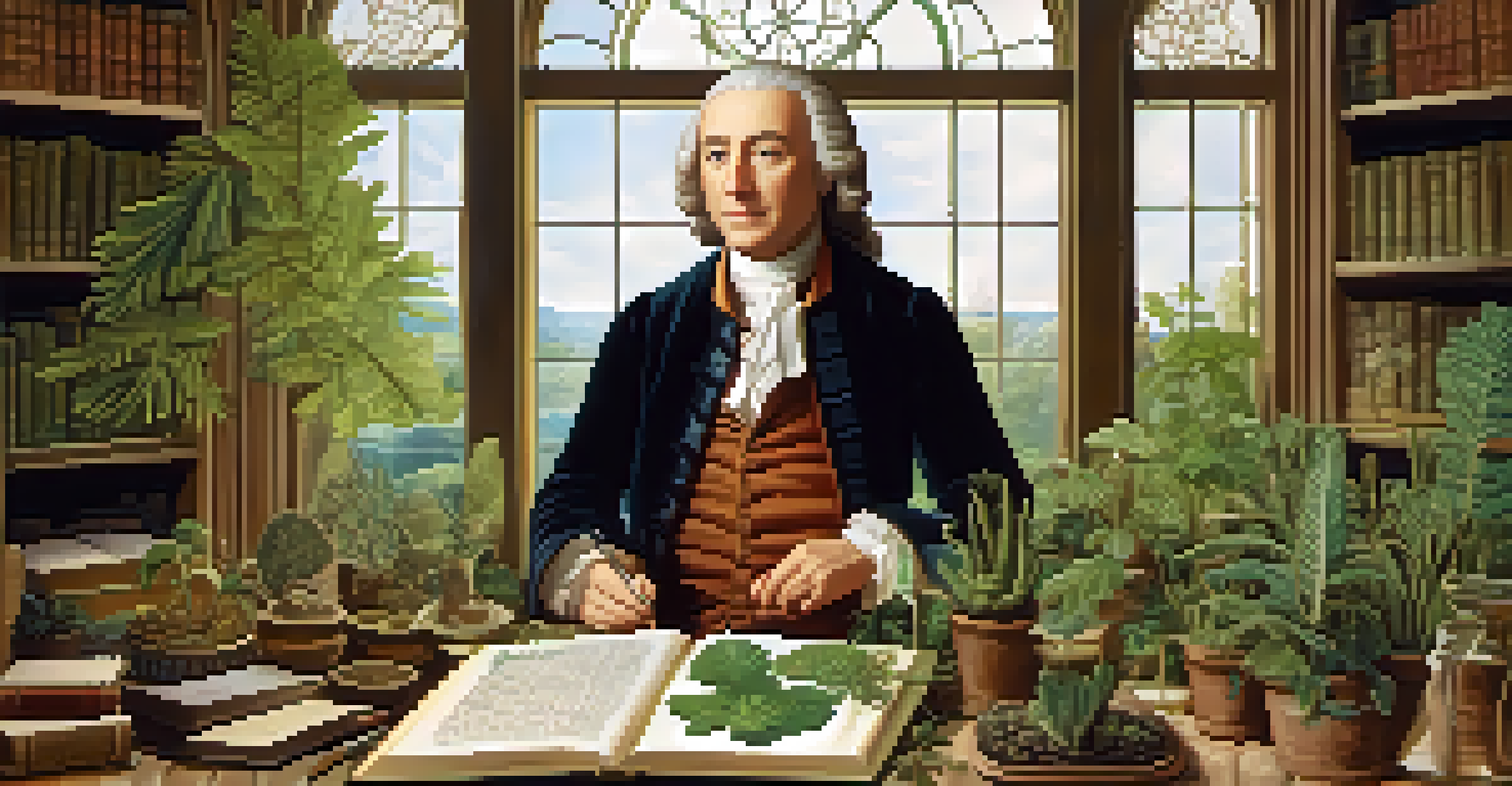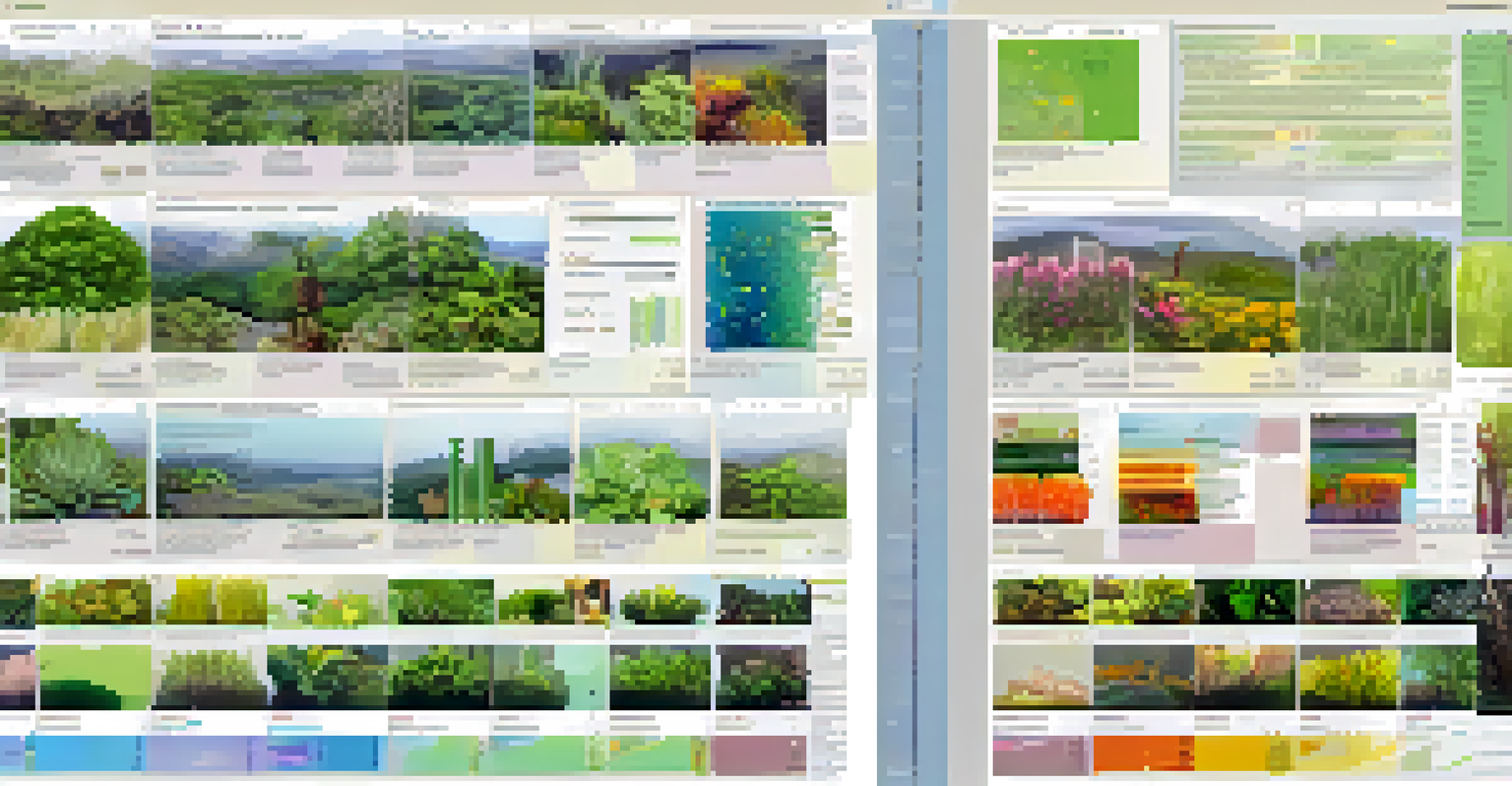The Evolution of Plant Taxonomy: Historical Perspectives

Understanding Plant Taxonomy: A Brief Introduction
Plant taxonomy is the science of naming, describing, and classifying plants. It serves as the foundation for understanding the Earth's biodiversity and the relationships between different species. By organizing plants into categories, taxonomists help both scientists and the general public identify and study various species more effectively.
The more we study the more we discover that we have only scratched the surface of the universe’s vastness.
The importance of taxonomy cannot be overstated; it provides a universal language for botanists and conservationists. This is crucial in a world where plant species are rapidly declining due to habitat loss and climate change. A solid taxonomy allows for better communication and collaboration across different regions and disciplines.
Historically, the classification of plants has evolved from simple naming conventions to more complex systems based on genetic relationships. Understanding this evolution helps us appreciate the scientific advances that have shaped our view of plant life and its significance on our planet.
Ancient Roots: Early Taxonomic Practices
The origins of plant taxonomy can be traced back to ancient civilizations, where herbalists and botanists first began categorizing plants. The Greeks and Romans, for instance, made significant contributions by documenting various plants and their uses in medicine and agriculture. These early classifications were often based on observable characteristics, such as leaf shape and flower color.

One of the earliest known taxonomists was the Greek philosopher Aristotle, who organized plants into categories based on their structure and habitat. His work laid the groundwork for future classification systems, although it was quite simplistic compared to modern standards. This early approach reflected the limited understanding of plant biology at the time.
Plant Taxonomy: Key to Biodiversity
Plant taxonomy is essential for understanding and preserving Earth's biodiversity by categorizing and identifying plant species.
As knowledge expanded, so did the complexity of plant classification. Ancient texts, such as Dioscorides' 'De Materia Medica,' provided valuable insights into the medicinal properties of plants, further highlighting the need for organized classification systems. This desire to categorize plants based on their uses was a precursor to more scientific methods that emerged later.
The Renaissance: A Surge in Botanical Discoveries
The Renaissance brought about a renewed interest in science and nature, leading to significant advancements in plant taxonomy. As explorers ventured into new territories, they encountered a plethora of unfamiliar plants, prompting the need for more organized classification. This period marked a turning point in how plants were studied and categorized.
If we could see the miracle of a single flower clearly, our whole life would change.
Botanists such as Carl Linnaeus emerged during this time, introducing a systematic approach to naming plants through binomial nomenclature. This method assigns each plant a two-part name, consisting of its genus and species, which is still used today. Linnaeus' work revolutionized plant taxonomy by providing a consistent framework for classification.
The impact of Linnaeus' work extended beyond taxonomy; it fostered a greater appreciation for plant diversity and ecology. His classification system allowed scientists to communicate more effectively about plant species, paving the way for future research and discovery. The Renaissance truly laid the foundation for modern plant taxonomy.
The 19th Century: Advancements in Plant Classification
The 19th century marked a period of rapid advancement in plant taxonomy, driven by new discoveries and evolving scientific methods. Botanists began to explore the relationships between plants in greater detail, leading to the development of more sophisticated classification systems. This era saw the introduction of phylogenetics, a science that examines the evolutionary relationships among species.
One notable figure during this time was Augustin Pyramus de Candolle, who contributed significantly to plant classification through his work on plant families. His observations on plant relationships helped establish a more natural classification system, focusing on evolutionary connections rather than superficial traits. This shift in perspective was crucial for the future of taxonomy.
Historical Evolution of Classification
The evolution of plant taxonomy from ancient practices to modern molecular techniques highlights the growing complexity of plant classification.
Additionally, the advent of microscopy and advances in genetics allowed taxonomists to study plants at a cellular level. This deeper understanding of plant biology further refined classification systems, leading to more accurate and comprehensive categorizations. The 19th century truly represented a turning point in the evolution of plant taxonomy.
The 20th Century: Molecular Techniques and Taxonomy
The 20th century saw a dramatic shift in plant taxonomy, primarily due to the advent of molecular techniques. With the discovery of DNA and its role in genetics, taxonomists began to incorporate molecular data into their classification systems. This allowed for a more accurate understanding of plant relationships and evolutionary history.
Molecular phylogenetics, which analyzes genetic material to determine evolutionary relationships, became a powerful tool for taxonomists. This approach revealed surprising connections between plant species and challenged long-held assumptions about their classifications. As a result, some plants were reclassified based on their genetic makeup rather than morphological traits.
The integration of molecular techniques has not only refined our understanding of plant taxonomy but also enhanced conservation efforts. By identifying genetic diversity within and among species, conservationists can make more informed decisions about preserving plant biodiversity. The 20th century's advancements have truly transformed the field of plant taxonomy.
Current Trends: Digital Taxonomy and Data Sharing
In recent years, the field of plant taxonomy has embraced digital technology, leading to the rise of digital taxonomy. This approach utilizes online databases and tools to catalog and share plant information globally, making it easier for researchers and enthusiasts to access data. Digital platforms have revolutionized the way taxonomists communicate and collaborate, breaking down geographical barriers.
Initiatives like the Global Biodiversity Information Facility (GBIF) have been pivotal in promoting data sharing among scientists worldwide. By providing open access to plant species data, researchers can build upon each other's work and contribute to a more comprehensive understanding of plant diversity. This collaborative spirit is essential for tackling global challenges like climate change and habitat loss.
Future Challenges and Innovations
While biodiversity loss poses significant challenges, advancements in technology and citizen science present new opportunities for plant taxonomy.
Furthermore, advancements in artificial intelligence (AI) are enhancing our ability to classify and identify plant species. AI technologies can analyze vast amounts of data quickly, aiding taxonomists in making more informed decisions. The future of plant taxonomy looks bright, with digital innovations paving the way for more efficient and accurate classifications.
The Future of Plant Taxonomy: Challenges and Opportunities
As we look to the future of plant taxonomy, several challenges and opportunities lie ahead. One significant challenge is the ongoing loss of plant biodiversity due to habitat destruction and climate change. As species decline, taxonomists face the urgent task of documenting and classifying these plants before they vanish, making conservation efforts more critical than ever.
On the other hand, advancements in technology present exciting opportunities for the field. With the rise of genomics and bioinformatics, taxonomists can explore plant relationships in unprecedented detail. This wealth of data can lead to more accurate classifications and a deeper understanding of plant evolution and diversity.

Moreover, the increasing emphasis on citizen science encourages public engagement in plant taxonomy. By involving non-scientists in data collection and identification, we can expand our knowledge base and foster a greater appreciation for plant diversity. The future of plant taxonomy is not only about scientific discovery but also about inspiring a global community to care for our planet's green treasures.